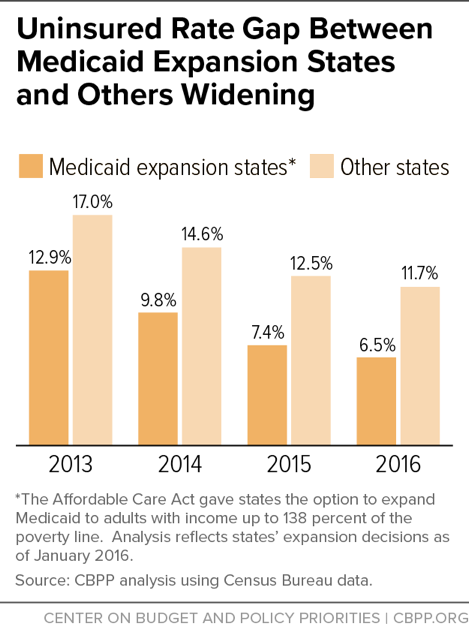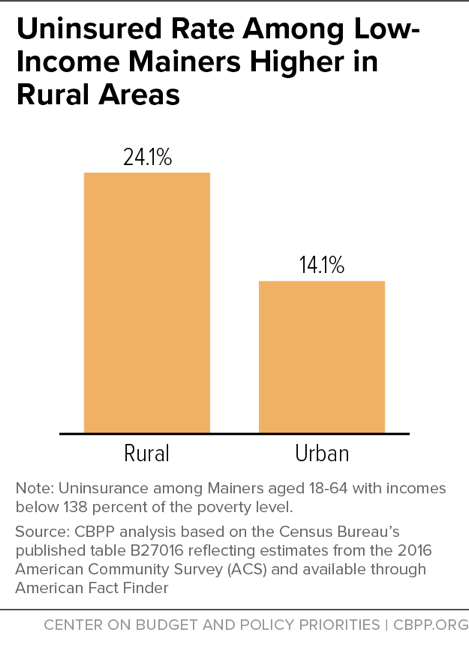On November 7, Maine voters will consider a ballot initiative to adopt the Affordable Care Act’s (ACA) Medicaid expansion which, if approved, would provide Medicaid coverage to more than 70,000 low-income Mainers. Maine Gov. Paul LePage, who five times has vetoed Medicaid expansion bills the Maine Legislature passed on a bipartisan basis, opposes the ballot initiative. The governor and others opposed to expansion have recycled many of the false and misleading arguments that conservative opponents of the Medicaid expansion in other states have used: that expansion would be too costly for the state, that it won’t reduce the share of Mainers who are uninsured, and that it would force the state to eliminate Medicaid services for seniors and people with disabilities.[1]
But Gov. LePage and other expansion opponents are likely vastly overstating Maine’s share of expansion costs; in fact, many states have found that expansion has produced net savings for their budgets — and is continuing to do so even as states are beginning to cover a share of the cost. States that have already expanded Medicaid have achieved the greatest gains in health coverage since the ACA took effect, with beneficiaries more easily accessing needed drug treatment and other behavioral health services and reporting that Medicaid coverage has made it easier to find and maintain employment. Among the uninsured Mainers likely to gain coverage through the expansion, most are employed but lack access to affordable health coverage, and the majority live in rural parts of the state. And as has been repeatedly shown, there’s no connection between states adopting the Medicaid expansion and people with disabilities’ access to Medicaid-covered home- and community-based services.
Gov. LePage’s Department of Health and Human Services (DHHS) projects that Medicaid expansion will cost Maine $315 million over five years,[2] which is substantially more than what the state’s nonpartisan Legislative Office of Fiscal and Policy Analysis and outside analysts project.
The Maine DHHS projections suffer from serious methodological flaws. For example, DHHS claims expansion will cost the state nearly $39 million in fiscal year 2017 — a year that has already ended and during which the state did not expand Medicaid.
DHHS also does not incorporate any offsetting budgetary savings to the state from expansion. Most states that have expanded Medicaid have realized savings, including reduced spending due to a drop in demand for targeted Medicaid programs that serve low-income people with specific health conditions (such as certain women with breast and cervical cancers) but are funded at the state’s regular, lower Medicaid matching rates;[3] and reduced spending on state-funded health programs that serve the uninsured, such as mental health and behavioral health programs. Maine is likely to realize these exact types of savings, a 2015 analysis prepared by Manatt Health Solutions found. [4]
In comparison, the legislative fiscal office incorporates $27 million in annual offsetting savings into its projections and finds that expansion will, on net, cost Maine about $128 million over four years.[5] (DHHS projects expansion will cost $276 million over the same period, when the fiscal year 2017 numbers are excluded.)
Even the legislative fiscal office’s projections likely overstate the cost of the Medicaid expansion. That’s because it assumes that the total federal and state cost of covering each childless adult expansion enrollee will be twice the cost of covering parents already eligible for Medicaid,[6] despite research showing the cost of covering expansion adults is roughly comparable to, or less than, the cost for currently eligible adults. For example, the Office of the Actuary of the Centers for Medicare and Medicaid Services found that the per-beneficiary cost of newly eligible expansion adults has fallen in recent years and is now in line with previously eligible adults, and is projected to be lower than previously eligible adults in the coming years.[7]
If the legislative fiscal office’s estimates are adjusted to assume an expansion per-beneficiary cost comparable to that of currently enrolled parents, its projections of Maine’s share of the cost of expansion would fall to about half of what the office currently projects, and to about a quarter of what DHHS projects.
The cost to Maine of enrolling more than 70,000 people in health coverage will likely be modest due to the structure of federal funding for the expansion. From 2014-2016, the federal government paid the entire cost of covering people enrolled in Medicaid expansion coverage. Beginning this year, states are paying a small share of the cost of coverage; by 2020 and for each year thereafter the federal government will pay 90 percent of the cost. Critics of Medicaid expansion like Gov. LePage have long claimed that this state share, which is substantially lower than what states pay for the rest of Medicaid (the federal government pays about 66 percent of the costs in Maine), would make expansion unaffordable in the long run.
Now, nearly four years after expansion first took effect, there are numerous examples of Medicaid expansion producing large offsetting savings across state budgets due to the factors discussed above. A number of states project that these savings will continue even as they begin paying a share of the cost of covering the newly eligible. For example:
- Arkansas. The state’s “private option” Medicaid expansion will produce net state savings each year through fiscal year 2021, and $637 million total from 2017-2021, according to a consultant’s report prepared for the state. These savings will be due to the state paying less to hospitals to cover uncompensated care costs and collecting more premium tax revenue, among other factors.[8]
- Colorado. Expansion will save the state money each year through state fiscal year 2020, and will produce $134 million in net savings to the state through 2026, according to a recent analysis from the Colorado Health Foundation.[9]
- Louisiana. The state expanded Medicaid on July 1, 2016. Expansion saved the state $199 million in the first fiscal year, and is expected to save the state an additional $350 million in the current fiscal year.[10]
- Michigan. Expansion will save the state money each year from 2014 to 2021, and nearly $2.7 billion total over that period, according to a New England Journal of Medicine study.[11] (The study’s authors did not look beyond 2021.) These savings come from a combination of increased tax revenue and savings in state health programs.
Studies have also shown that Medicaid expansion has not triggered a significant increase in state Medicaid spending, even as more than 11 million people have gained Medicaid coverage across the country. For example, a recent study in Health Affairs used 50-state data from 2010 to 2015 to look at changes in federal and state spending on Medicaid, along with spending in other budget areas, such as education and infrastructure. While Medicaid expansion was associated with a statistically significant increase in both total spending and federal spending on Medicaid after expansion took effect in 2014, expansion was not associated with a statistically significant increase in state spending on Medicaid, the study found.[12] Further, the authors note that their study looked only at spending within state Medicaid programs, and did not examine the expansion’s broader benefits for state budgets.
Maine Would Likely Make Rapid Gains in Health Coverage, Other States’ Experiences Suggest
The experience of states that have expanded Medicaid suggests that Maine will experience large gains in health coverage if it adopts the expansion. Opponents claim, however, that Medicaid expansion is unlikely to affect health coverage in the state.[13]
While all states have experienced coverage gains since the ACA’s major coverage provisions took effect in 2014, states that expanded Medicaid have made the largest gains. The uninsured rate in expansion states was cut in half from 2013 to 2016, while it dropped by 31 percent in states that did not expand, according to recent Census Bureau estimates.[14] (See Figure 1.) On a per-state basis, the nine states with the largest coverage gains since 2013 expanded Medicaid.
These gains came despite the fact that expansion states had higher coverage levels than non-expansion states before the ACA took effect. So Maine, which currently provides Medicaid coverage to parents with incomes up to 105 percent of the poverty line (about $12,700 a year for an individual), will still experience coverage gains if eligibility is extended to low-income non-elderly adults without children through expansion.
Majority of Low-Income Mainers Are Employed, Living in Rural Areas
Of the uninsured childless adult Mainers with incomes below 138 percent of the poverty line (about $16,600 a year for an individual) — the income range for those who would gain Medicaid eligibility under expansion — 58 percent are working, according to CBPP analysis of Census Bureau data.[15] These uninsured workers are concentrated in industries such as restaurants and food service, construction, and grocery stores. (See Table 1.)
| TABLE 1 |
|---|
| Top Ten Industries of Mainers Set to Gain Medicaid Eligibility |
|---|
| Uninsured Workers |
15,290 |
|---|
| |
Restaurants and other food services |
2,220 |
| |
Construction |
1,770 |
| |
Grocery stores |
1,500 |
| |
Building services (janitor, extermination) |
890 |
| |
Gasoline stations |
770 |
| |
Private household services (gardeners, cooks, caretakers) |
700 |
| |
Department stores |
690 |
| |
Retail bakeries |
530 |
| |
Automotive stores |
520 |
| |
Employment services (temp agencies) |
460 |
Medicaid expansion would have major benefits for rural Mainers. Among non-elderly adult Mainers with incomes below 138 percent of the poverty line, 55 percent live in rural parts of the state. Medicaid expansion holds the most promise for rural Maine, since 24 percent of Mainers in rural areas in this income range are uninsured, compared to 14 percent of Mainers in urban areas.[16] (See Figure 2.)
Medicaid Expansion Supports Employment and Worker Productivity
Opponents of Maine’s Medicaid expansion have suggested that childless adults with incomes below the poverty line should just earn more money to become eligible for subsidies to purchase marketplace coverage or seek care at federally qualified health centers.[17] But research shows that Medicaid expansion does not discourage work. In fact, it supports employment. For example, using Oregon Health Study data, researchers found no statistically significant difference between a group of low-income adults selected for Medicaid and a control group that remained on a waiting list and uninsured, either in the share with earnings or in the amount of earnings.[18]
More broadly, according to a recent Kaiser Family Foundation literature review of studies examining the impact of Medicaid expansion, “no studies found negative effects of expansion on employment and employment behavior. Studies examining employment rates and other measures such as transitions from employment to non-employment, the rate of job switches, transitions from full- to part-time employment, labor force participation, and usual hours worked per week have not found significant effects of Medicaid expansion.”[19]
Surveys of Medicaid expansion beneficiaries in Ohio and Michigan have found that Medicaid expansion has made it easier for people to look for work and maintain employment. In Ohio, among expansion enrollees who were unemployed and looking for work when they gained coverage, 75 percent said Medicaid made the task easier. Among those who were employed, half said Medicaid made it easier to stay working.[20]
In Michigan, 55 percent of enrollees who were unemployed said expansion coverage made them better able to look for a job, and 69 percent of those who were working said they did better at their jobs once they had coverage.[21]
Opponents of Maine’s Medicaid expansion have recycled the widely debunked claim[22] that Medicaid expansion is squeezing funding for other Medicaid beneficiaries, and creating waiting lists among non-expansion beneficiaries.[23] Medicaid expansion will lead to “our most vulnerable neighbors languishing on waiting lists, or facing huge cuts to their services,” the state’s Republican Party has written.[24]
There are no waiting lists to enroll in Medicaid; states must enroll all eligible beneficiaries, including children, seniors, people with disabilities, and adults, in coverage — without exception. States can — and many do — have waiting lists for Medicaid’s home- and community-based services (HCBS), which give people needing long-term services an alternative to nursing homes. Gov. LePage and other conservative policymakers have said the Medicaid expansion is responsible. In reality, there’s no connection between the two. Nine of the 11 states without HCBS waiting lists are expansion states, and the non-expansion states of Florida and Texas have the biggest waiting lists.[25] And in July, Ohio Gov. John Kasich blasted Vice President Mike Pence for suggesting 60,000 disabled Ohioans are on a waiting list for services that was caused by Medicaid expansion. This accusation is “false, and it is just the opposite of what actually happened,” Gov. Kasich’s spokesman said.[26]
States that have expanded Medicaid as part of the ACA have experienced the largest gains in health coverage, and in many, expansion has produced state budget savings. Those who have gained coverage report that they are better able to seek and maintain employment. An upcoming ballot initiative in Maine, if approved, would have similar impacts on the state and its residents. Medicaid expansion would create a pathway to affordable health coverage for Maine’s uninsured low-income workers, and for the state’s rural residents who have a higher rate of uninsurance than their urban counterparts.



